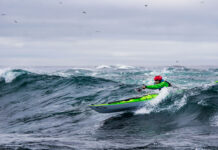The U.S. Coast Guard has released its 2021 boating accident data.
“The good news is that after the explosive growth and record number of accidents and fatalities that occurred during the pandemic year of 2020, the number of recreational boating incidents and fatalities declined in 2021,” says Water Sports Foundation Executive Director Jim Emmons.
Total deaths fell from 767 in 2020 to 658 in 2021, a 14.2 percent decline. However, “Paddlecraft deaths still remain high, and kayaks are listed as the vessel type with the second highest fatalities behind open motorboats,” Emmons adds. There were 160 fatalities while kayaking, canoeing and paddleboarding in 2021, versus 164 in 2020.
The U.S. Coast Guard reports:
- Kayaks are listed as the vessel type with the second highest fatalities (15 percent), behind open motorboats (44 percent)
- In 2021, there were 96 fatalities while kayaking, compared to 112 in 2020
- In 2021, there were 46 fatalities while canoeing, compared to 42 in 2020
- In 2021, there were 18 fatalities while standup paddleboarding, compared to 10 in 2020
- Where cause of death was known, 81 percent of fatal boating accident victims drowned. Of those victims with reported life jacket usage, 83 percent were not wearing a life jacket
- Alcohol use is the leading known contributing factor in fatal recreational boating accidents; where the primary cause was known, it was listed as the leading factor in 16 percent of deaths
To reduce risk on the water, paddlers should:
How The U.S. Coast Guard Research Is Conducted
The U.S. Coast Guard compiles statistics on reported recreational boating accidents. These statistics are from accident reports filed by the owners and operators of recreational vessels involved in accidents. The 50 states, five U.S. territories and the District of Columbia submit accident report data to the Coast Guard for inclusion. Access the full 2021 Boating Accident Report Data here.








